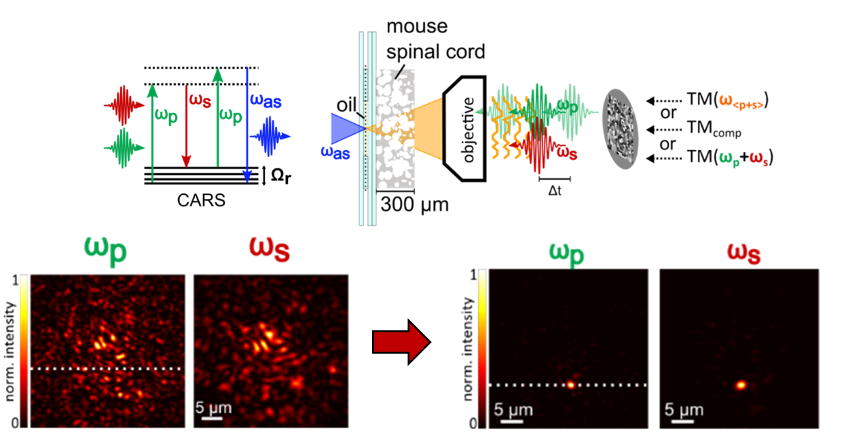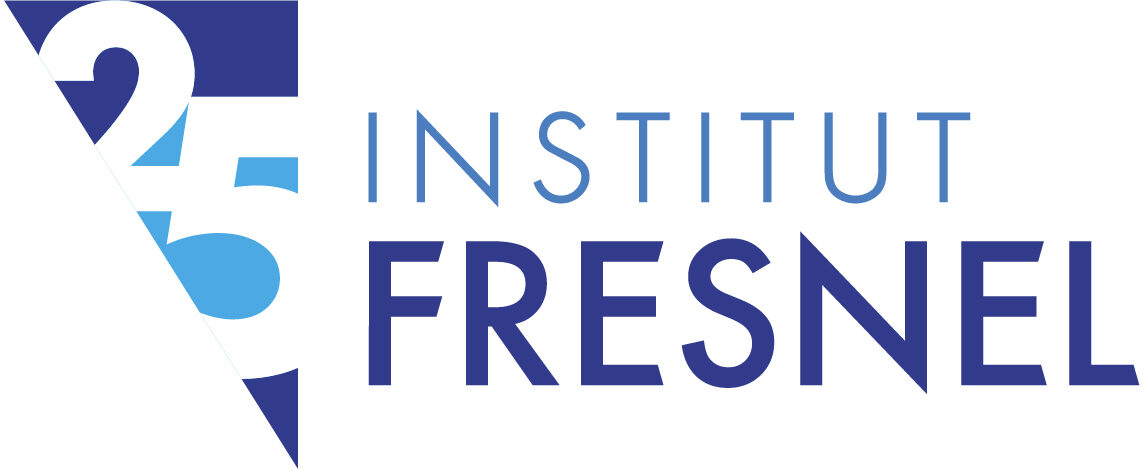For in-depth nonlinear imaging in tissues
Principal investigators : Sophie Brasselet
Keywords: in-depth two-photon and coherent Raman scattering (CRS) imaging, wavefront shaping, adaptive optics
The potential of label-free imaging techniques based on nonlinear optics presents limits in turbid or heterogeneous media like biological tissues. Thanks to recent advances in wavefront control technologies (spatial light modulators based on liquid crystals, deformable mirrors), imaging in such media is now possible. We explore different directions for improving in-depth nonlinear imaging, using adaptive optics techniques (based on the correction of optical aberrations) or wavefront shaping (based on the manipulation of high spatial frequencies, which is necessary for imaging through multiply scattering media). We are in particular interested in exploiting the concepts of optimization together with transmission and reflection matrices of a scattering medium, to benefit from the manipulation of coherent incident pulses for the recovery of polarization-sensitive, nonlinear signals.
Main recent achievements :
Adaptive optics and wavefront shaping for frequency mixing nonlinear microscopy
Noninear imaging at depths larger than a few scattering mean free paths (above a few hundreds of microns in tissues) is challenged by randomized scattering optical paths that mix all available information. Manipulating optical wavefronts for nonlinear imaging is even more constraining when working under broadband excitations (typically below a 100fs pulse width) with different uncorrelated frequencies, such as for four wave mixing (FWM) or coherent Raman scattering (CRS) generation. We have developed two different approaches for wavefront shaping under such conditions, one based on the measurement of the transmission matrix (TM) of the medium, the other one based on direct optimization of a FWM/CRS signal inside the medium.
By a coherent combination of broadband Transmission Matrices measured through a medium in different spectral regions, we demonstrate the possible recovery of a CRS signal at several hundreds of microns behind a mouse spinal cord tissue. On the other hand to image within a tissue, we show that feedback loop optimization requires the manipulation of thousands of spatial modes. We show that such approach permits the recovery of vibrational Raman signatures of lipids in myelin inside spinal cord tissues. Thanks to the coherent nature of waves manipulation in a broadband regime, both TM and optimization methods maintain the capabilities of refocusing different spectral frequencies in space and time, allowing FWM and CRS generation.

Adaptive optics and wavefront shaping for polarization resolved nonlinear imaging
Despite remarkable developments in polarization-resolved imaging for life sciences, their transposition to strongly scattering media is limited by the inherent depolarization effects arising from multiple scattering. We show however that the use of adaptive optics is able to preserve almost intact polarization resolved response, thanks to its coherent manipulation of ballistic light photons. We also show that wavefront shaping can help recover polarization-resolved responses even in strongly scattering media conditions : this polarization recovery is helped by broadband wavefront shaping which serves as a filter for short path photons propagation in the medium. These observations paves the way for extending current polarization-based methods to strongly scattering environments.
Methodologies and experimental techniques
– Adaptive optics for in-depth two-photon and four-wave-mixing microscopy
– Wavefront shaping based on the transmission matrix measurement of a complex medium
– Imaging inside scattering media based on the reflection matrix measurement of a complex medium
Publications
2020
L Zhu, J Boutet de Monvel, P Berto, S Brasselet, S Gigan, M Guillon.
Chromato-axial memory effect through a forward-scattering slab.
Optica 7 (4), pp.338 (2020) DOI : 10.1364/OPTICA.382209
M Hofer, S Shivkumar, B El Waly, S Brasselet.
Coherent anti-Stokes Raman scattering through thick biological tissues by single wavefront shaping.
arXiv:2003.03761, Phys Rev Applied 14, 024019 (2020) DOI : 10.1103/PhysRevApplied.14.024019
2019
A.G. Vesga, M. Hofer, N. Kumar Balla, H. B. De Aguiar, M. Guillon, S. Brasselet,
Focusing large spectral bandwidths through scattering media,
Opt. Express 27 (20), 28384-28394 (2019) DOI : 10.1364/OE.27.028384. arXiv:1908.01243.
M. Hofer, S. Brasselet,
Manipulating the transmission matrix of scattering media for nonlinear imaging beyond the memory effect,
Opt. Letters 44(9), 2137-2140 (2019), DOI : 10.1364/OL.44.002137, arXiv:1904.10695
2018
M. Hofer, C. Soeller, S.Brasselet, J. Bertolotti,
Wide field fluorescence epi-microscopy behind a scattering medium enabled by speckle correlations,
Opt. Express 26 (8), 9866-9881 (2018) DOI : 10.1364/OE.26.009866
2017
H.B. De Aguiar, S. Gigan, S. Brasselet,
Polarization recovery through scattering media,
Science Advances 3 (9), e1600743 ; (2017), DOI : 10.1126/sciadv.1600743
D. Champelovier, J. Teixeira, J. M. Conan, N. Balla, L. M. Mugnier, T. Tressard, S. Reichinnek, S. Meimon, R. Cossart, H. Rigneault, S. Monneret, and A. Malvache
Image-based adaptive optics for in vivo imaging in the hippocampus
Sci. Rep. 7, 42924 (2017)

